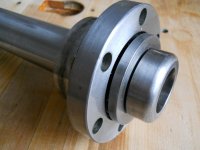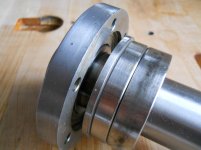morsetaper2
Diamond
- Joined
- Jul 2, 2002
- Location
- Gaithersburg, MD USA
In THIS THREAD I asked about Pratt & Whitney 3C horizontal milling machines as I was offered one. I actually made the deal and moved the machine last weekend. Much of it is still in boxes, especially the nice tooling selection that came with it. As the machine gets reassembled I'll add photos and text. Never having operated a horizontal mill I’m going to have my own questions to ask. So I’ll be posting them here.
It was broken down in pieces such that my brother and I could move it out of tight quarters in a basement and up some stairs. Two 90* turns involved, one at the bottom of stairs and another at the top thru a doorway.
I boxed up all the tooling and disconnected all the electrical connections and disassembled the mill as best I could a couple nights before the move. I separated the table and the knee from the mill main casting. Removed the Speed Ranger Drive as one lump. Then unscrewed the tabletop, we flipped it over and removed the Speed Ranger Hanging brackets. The cabinet went up the stairs on a handtruck. All the other pieces were horsed up the stairs by my brother and I.
At this point I have the cabinet back together, the Speed Ranger Installed, and main column assy bolted back on the table. All I plan to do is clean it up. At this point it appears to be in excellent shape. Just needs 70 years worth of cleaning. I am guessing this machine was built sometime about WWII?? But don’t really know. I worked in the Aerospace machine Shop at the U of MD in the late 90’s. I first saw this machine there. It came from some other facility on campus. A more senior machinist took ownership of the machine and he has had it since. He hunted me down and gave me first right of refusal.
Some photos of it in its current state in my garage. More to come as the reassembly progresses.


It was broken down in pieces such that my brother and I could move it out of tight quarters in a basement and up some stairs. Two 90* turns involved, one at the bottom of stairs and another at the top thru a doorway.
I boxed up all the tooling and disconnected all the electrical connections and disassembled the mill as best I could a couple nights before the move. I separated the table and the knee from the mill main casting. Removed the Speed Ranger Drive as one lump. Then unscrewed the tabletop, we flipped it over and removed the Speed Ranger Hanging brackets. The cabinet went up the stairs on a handtruck. All the other pieces were horsed up the stairs by my brother and I.
At this point I have the cabinet back together, the Speed Ranger Installed, and main column assy bolted back on the table. All I plan to do is clean it up. At this point it appears to be in excellent shape. Just needs 70 years worth of cleaning. I am guessing this machine was built sometime about WWII?? But don’t really know. I worked in the Aerospace machine Shop at the U of MD in the late 90’s. I first saw this machine there. It came from some other facility on campus. A more senior machinist took ownership of the machine and he has had it since. He hunted me down and gave me first right of refusal.
Some photos of it in its current state in my garage. More to come as the reassembly progresses.












 with more details.
with more details.